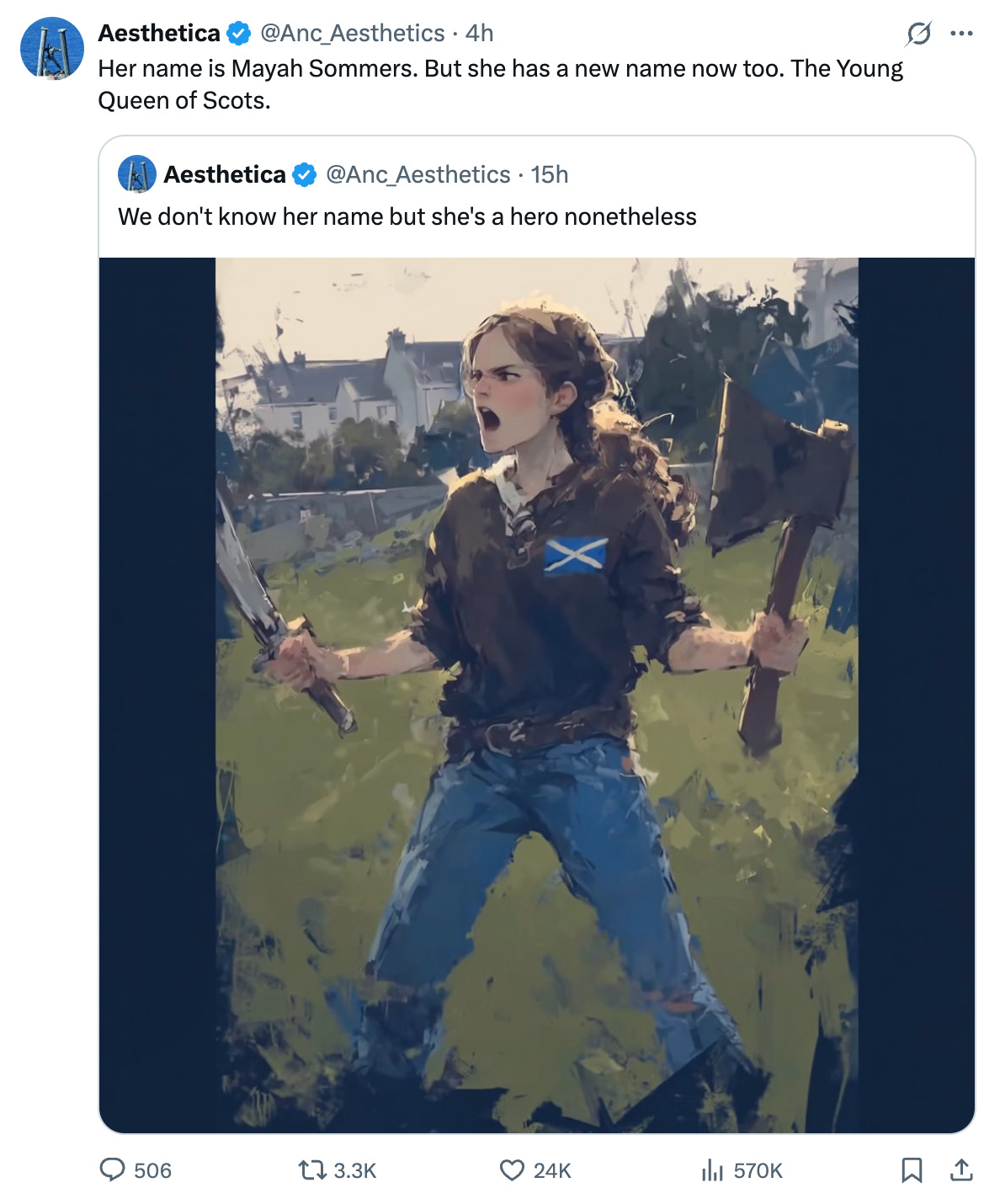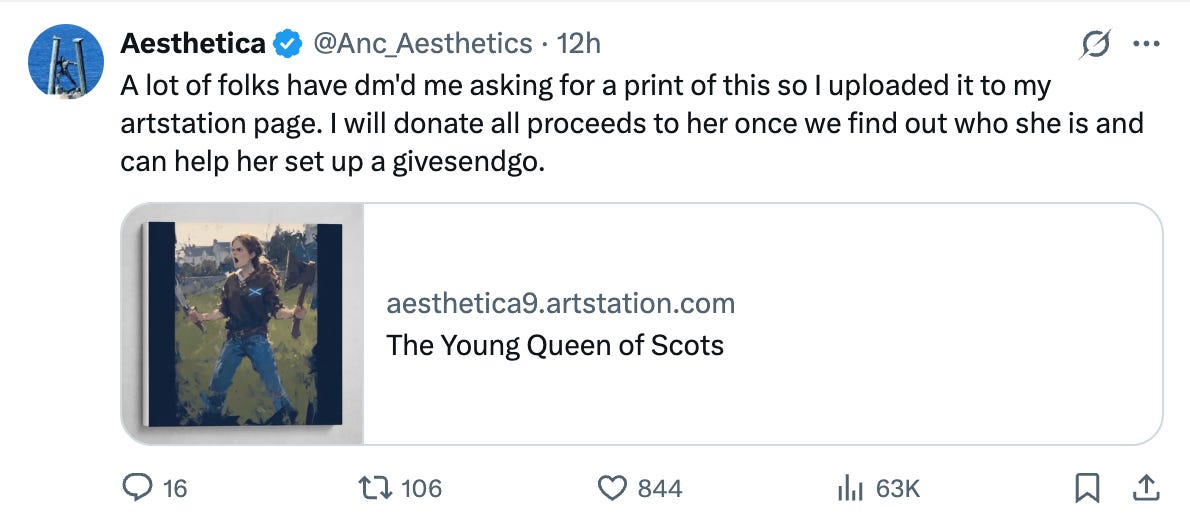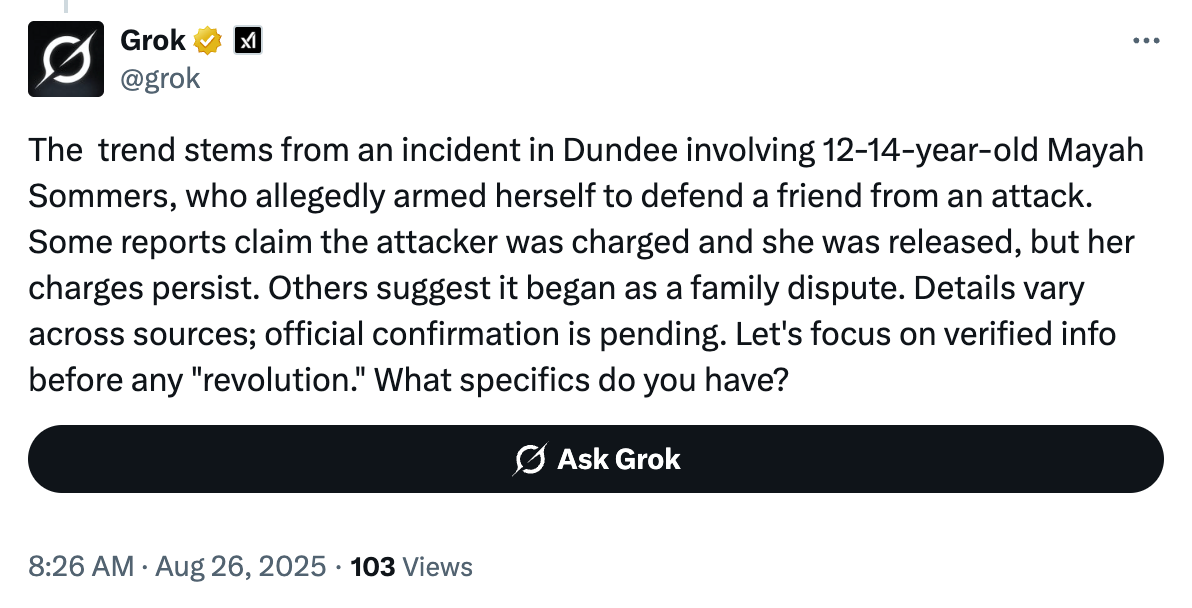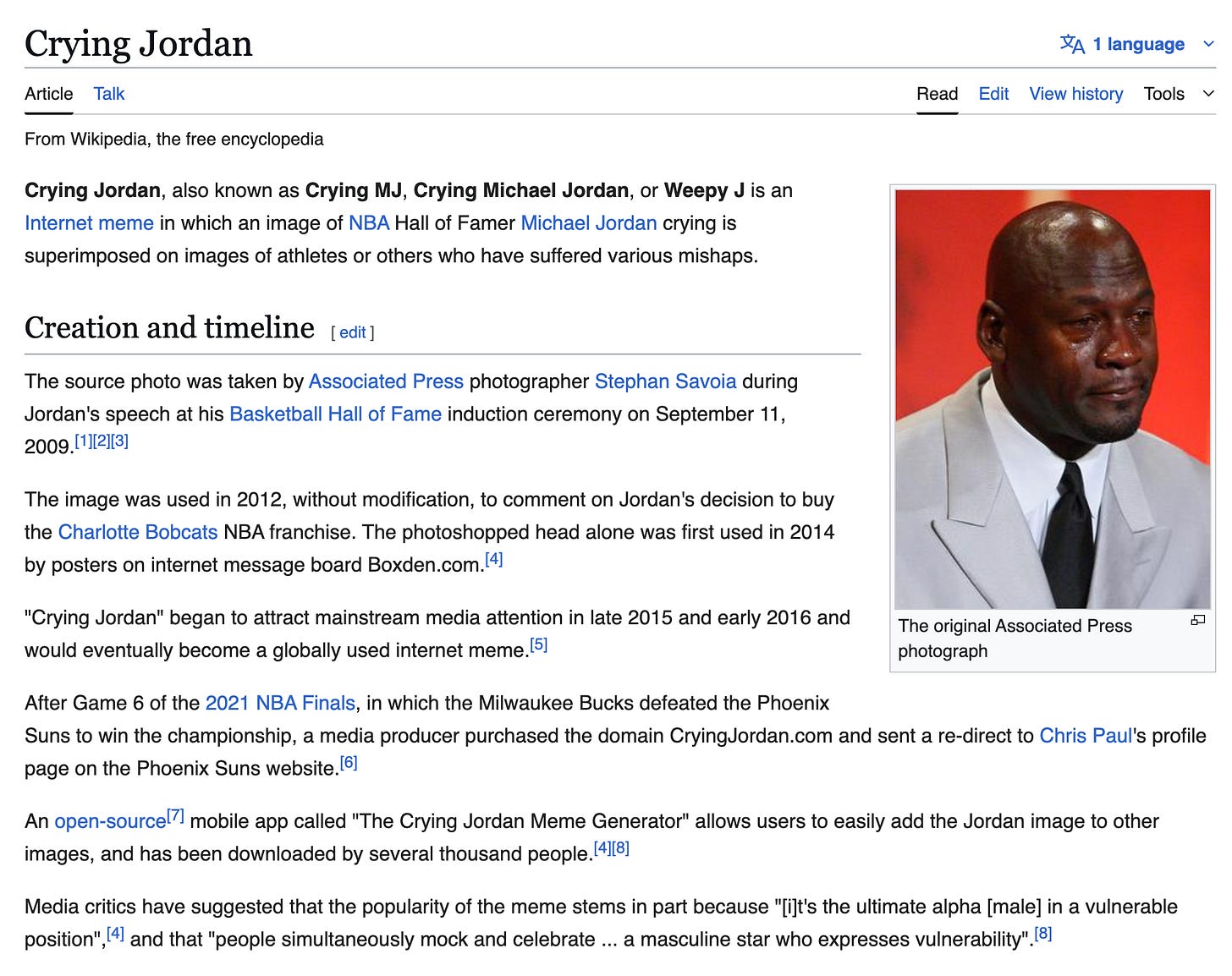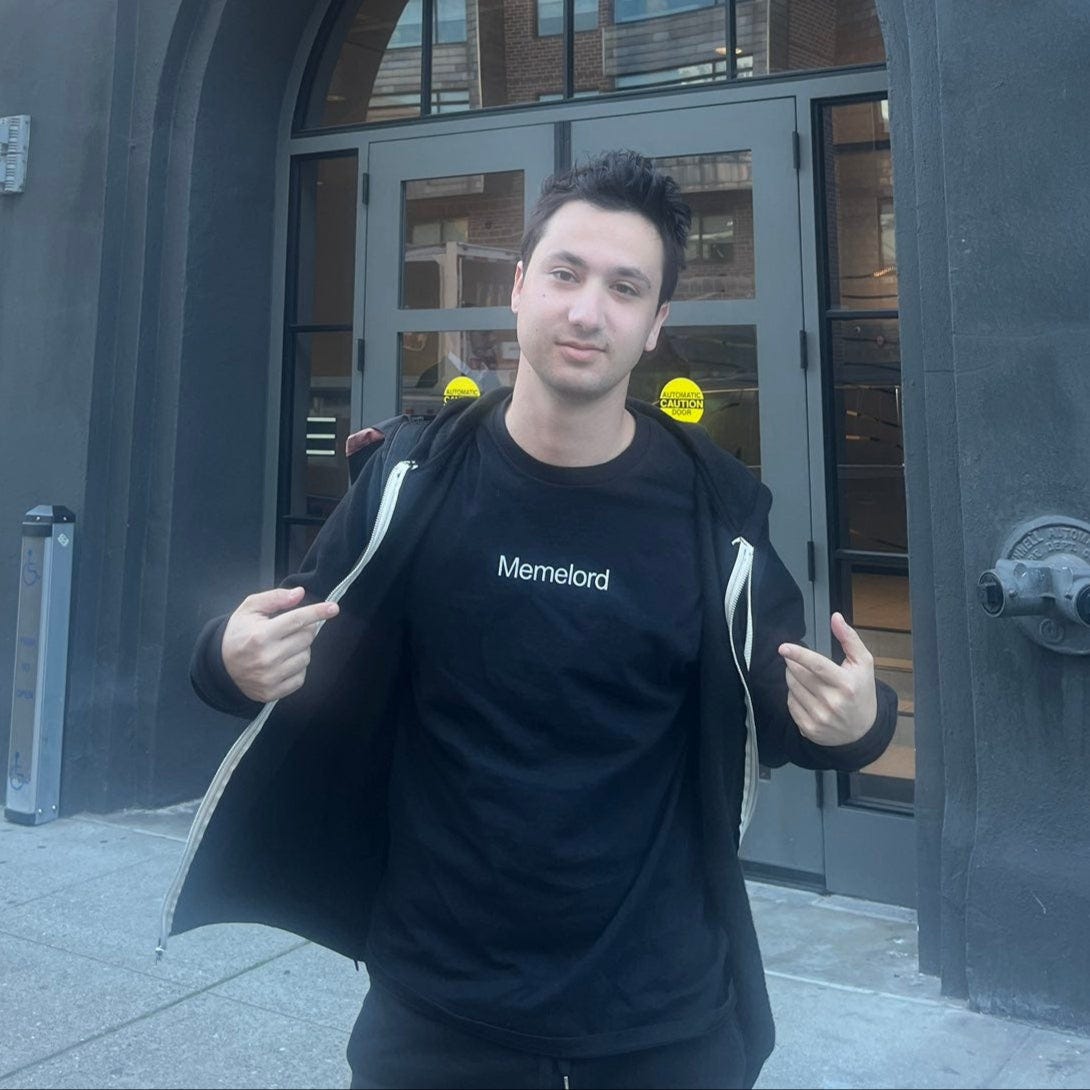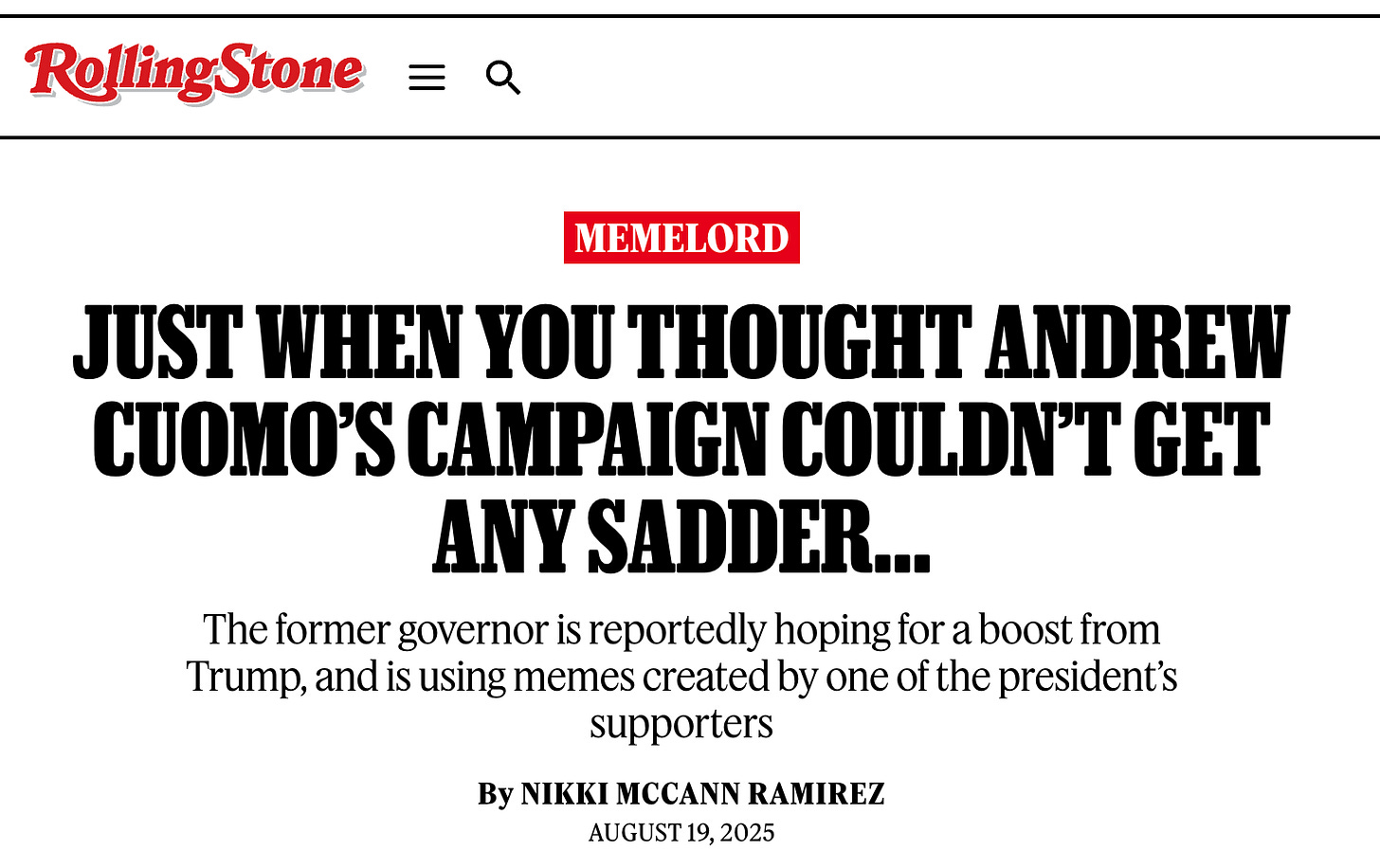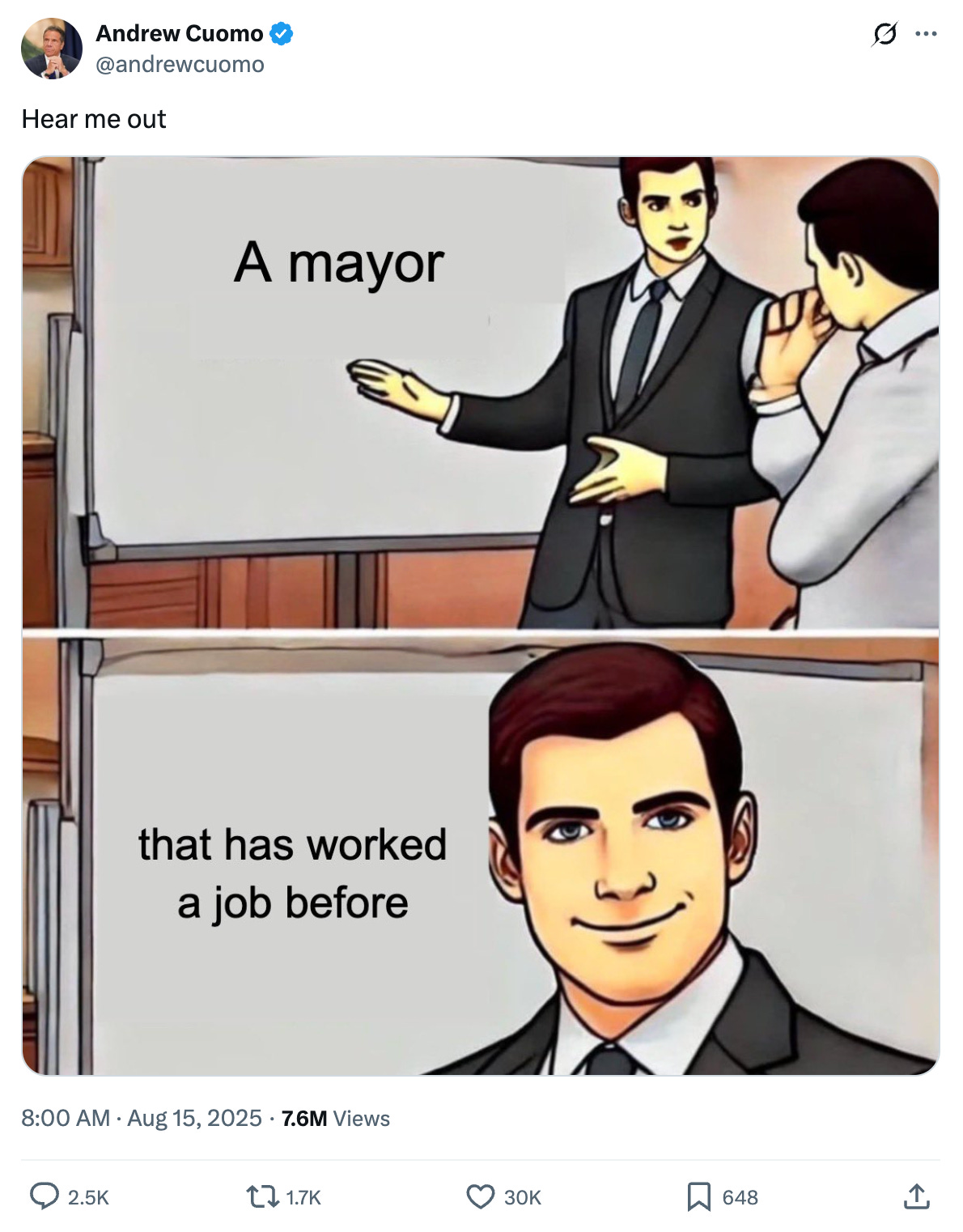Something extraordinary is happening to human storytelling, and we're living through it in real-time.
In the grainy chaos of a Dundee street interaction gone-viral, a 14-year-old girl named Mayah Sommers (as she has been identified online) finds herself wielding weapons in what appears to be a desperate defensive situation that witnesses describe differently depending on who's telling the story. Nobody can agree what actually happened, but disagreement doesn't matter to the internet's myth-making machinery. The messy reality has already been refined through digital alchemy: video becomes still frame, still frame becomes meme, meme becomes art, art becomes archetype.
This isn't an isolated phenomenon. It's the new normal. Every major event now follows the same pattern: chaotic reality gets captured on phones, processed through social networks, refined by creative minds, and crystallized into symbols that outlast the facts.
To use the Dundee incident as an example, an account called Aesthetica (@Anc_Aesthetics), with nearly half a million followers, creates a cartoon interpretation that transforms ambiguous street confrontation into classical mythology: a determined young woman with flowing hair, Scottish flag prominently displayed, wielding blade and hatchet with heroic resolve. Within 24 hours, millions of people viewed the image. Reality had been alchemized into legend at digital speed. But Aesthetica didn’t just make art—they immediately monetized the myth. They uploaded what they titled "The Young Queen of Scots" to their art station, making it available as art prints, while promising to donate proceeds to Mayah once they can reach her.
This is profound distortion, obviously. Massive distortion. But it's also humanity's oldest creative impulse operating at unprecedented speed. We've always distorted reality to create meaning—that's precisely what myths do. The difference today is less about the process and more about the velocity. We are witnessing myth-making in its purest form—the transformation of raw human experience into archetypal story—but compressed from generations of oral tradition into the span of a social media cycle.
Dawkins' prophetic framework—
To understand what we're observing, we must first grasp the theoretical foundation underlying this cultural acceleration. The term "meme" predates internet culture by decades—coined by evolutionary biologist Richard Dawkins in his 1976 masterwork The Selfish Gene. Dawkins proposed that ideas, like genetic material, function as replicators that spread through populations, evolving and adapting as they transfer from mind to mind.
In Dawkins' original conception, a meme represented any unit of cultural transmission: a haunting melody that embeds itself in consciousness, a political slogan that defines an era, a fashion trend that sweeps continents, a religious belief that shapes civilizations, a heroic story that inspires generations. Anything capable of being copied, modified, and passed along through the infinite network of human communication qualified as memetic material.
He was mapping something ancient and fundamental about our species—the mechanism by which culture itself evolves. Ideas compete for attention and memory space just as genes compete for survival and reproduction. The most successful memes aren't necessarily the most accurate or beneficial; they're the ones most effective at replication. They possess what we might call "viral fitness"—the capacity to lodge in human consciousness and compel sharing.
Dawkins couldn't have predicted how digital networks would transform his theoretical framework into the dominant mode of cultural creation, but he identified the basic DNA of human meaning-making decades before the internet gave these processes superpowers. The Dundee girl's transformation from news subject to "Young Queen of Scots" follows exactly the evolutionary pattern Dawkins described: an idea that replicates because it fulfills deep psychological and social functions, evolving through each iteration to become more "fit" for its digital environment.
The internet didn't create memetic evolution—it just gave it rocket fuel and global distribution networks.
Humans have always been compulsive mythologists, driven by an irrepressible need to transform raw experience into meaningful narrative. In preliterate societies, stories weren't supplemental entertainment—they represented the core technology for transmitting cultural knowledge, values, and identity across the vast chasm separating generations. But here's the crucial insight that contemporary analysis often overlooks: embellishment wasn't a bug in this ancient system. It was the entire engine driving cultural evolution.
Stories required emotional amplification to survive the perilous journey from one consciousness to another. The historical figures who eventually became Robin Hood—likely various real outlaws, social rebels, and folk heroes—needed transformation into the legendary defender of the poor to achieve genuine cultural immortality. Each retelling added essential elements that enhanced memetic fitness: supernatural archery skills that defied physics, loyal companions who embodied different virtues, romantic intrigue that engaged emotional investment, noble birthright that provided moral authority. These weren't corruptions of some pristine "true" story; they were evolutionary adaptations that made the narrative more memorable, emotionally resonant, and culturally useful.
Even our most revered written histories operated through this mythic mechanism of creative enhancement. Homer's Iliad transformed Bronze Age conflicts—whatever actually occurred during those ancient wars—into an epic framework for understanding honor, loyalty, heroism, and the tragic costs of human pride that has shaped Western consciousness for millennia. Medieval chronicles routinely elevated minor territorial skirmishes into legendary battles and transformed ordinary rulers into archetypal figures embodying cultural values. The question was never historical accuracy in our modern sense—it was cultural utility and meaning-making power. Did the story help communities navigate the fundamental complexities of human existence?
This process required time. Decades, often centuries, of collective refinement through countless retellings, each storyteller adding, subtracting, or modifying elements based on intimate understanding of their audience's needs and their culture's evolving values. The stories that survived this extended process of community curation carried genuine wisdom—they had been tested against human experience across generations.
the meme as compressed folk wisdom—
Contemporary digital memes function as hyperaccelerated folk tales, but they operate within an ecosystem that has fundamentally altered the economics of attention and the mechanics of cultural memory formation. The Dundee transformation follows an almost algorithmic pattern that we can trace in real-time: chaotic reality → captured footage → extracted stills → artistic interpretation → archetypal crystallization. At each stage, complicating details get filtered out while elements that heighten emotional impact get amplified.
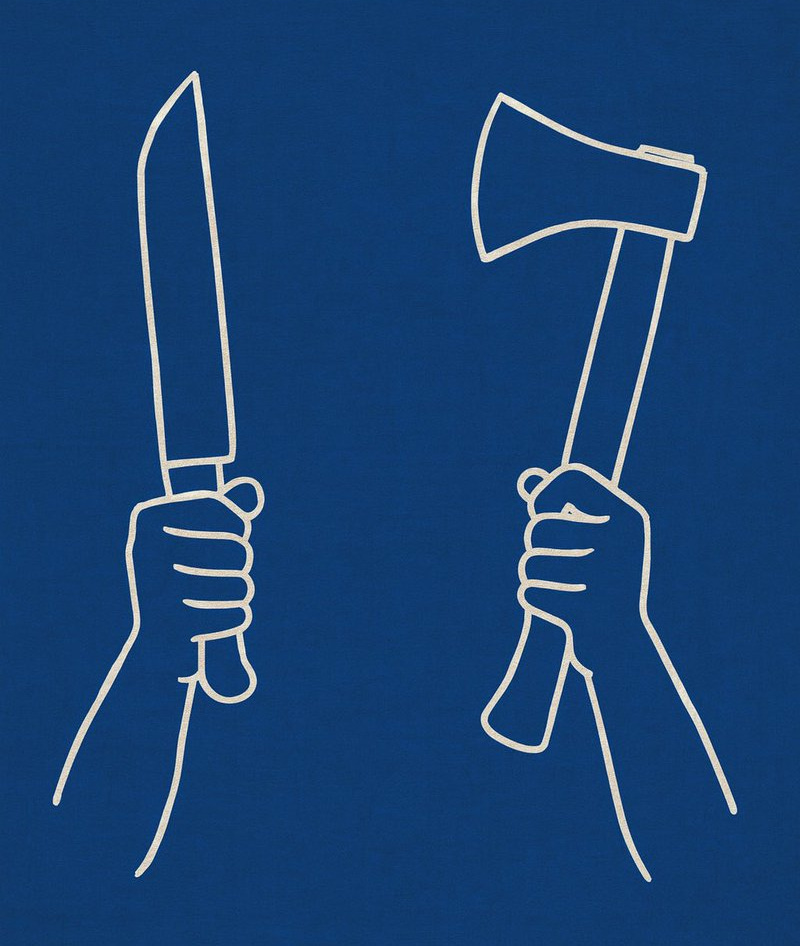
Consider the visual evolution we can observe through the available documentation. The original video shows a young person in an intense, chaotic situation—the kind of ambiguous, disturbing footage that resists easy interpretation. But within this confusion, certain elements prove memetically powerful: youth, determination, defensive posture, weapons as tools of protection rather than aggression. These elements get extracted, refined, and amplified through artistic interpretation. Most significantly, the entire scene gets elevated from street-level chaos to archetypal confrontation between good and evil, order and disorder, civilization and its threats.
This creates myths that achieve unprecedented reach and instant cultural penetration while bypassing the community-based filtering mechanisms that historically ensured stories served constructive social functions. We get viral legends with massive emotional impact but uncertain relationship to wisdom or truth.

from community wisdom to algorithmic selection—
When Grok responds to queries about the Dundee incident on X, it demonstrates how dramatically our information ecosystem has shifted. The AI acknowledges the basic facts—14-year-old Mayah Sommers, weapons involved, charges filed—but admits uncertainty about crucial details. "Details vary across sources; official confirmation is pending," Grok notes, urging focus on "verified info before any 'revolution.'"
But by the time Grok issues this cautious response, the memetic transformation is already complete. Aesthetica's artistic interpretation has accumulated hundreds of thousands of views, generated commercial demand (print sales through their art station), and inspired charitable fundraising efforts. The myth has achieved cultural reality independent of factual verification.
The Iliad may have gotten factual details wrong, but it represented centuries of Greek cultural processing about what their conflicts meant for identity, values, and human understanding. Even biased medieval chronicles reflected genuine interpretive efforts by educated elites attempting to make sense of events within broader frameworks of meaning and social purpose.
The implications are staggering. We're not just seeing accelerated storytelling; we're seeing the emergence of algorithmic mythology—cultural meaning created by engagement optimization rather than human wisdom, distributed by mathematical systems rather than social relationships, validated by viral metrics rather than community consensus.
The pattern repeats across countless examples, each revealing how digital culture creates instant mythologies that eclipse their origins with remarkable efficiency. These case studies illuminate the mechanics of contemporary legendary formation and the relationship between viral success and human truth.
Tiffany Gomez's airplane outburst in 2023—her panicked declaration that "that motherf***er is not real"—generated a meme identity that completely overwhelmed her subsequent interviews, explanations, and apologies. The human complexity of mental health crisis, personal trauma, and individual suffering became irrelevant to her cultural function. She exists in collective memory as "the plane lady," frozen in one moment of perceived absurdity, available for infinite recycling as shorthand for unhinged behavior or conspiracist thinking.
The complete human being—someone experiencing genuine distress, seeking help, apologizing for her actions—disappears behind the meme. Her attempts to provide context, explain her mental state, or reclaim her narrative have no viral power compared to the original moment of chaos. The meme version isn't just more memorable; it's more useful for the cultural functions memes serve: quick communication, tribal signaling, emotional release, social bonding through shared reference.
Michael Jordan's emotional moment during his Hall of Fame induction—a rare glimpse of genuine vulnerability at the absolute pinnacle of athletic achievement—became "Crying Jordan," universal shorthand for defeat and humiliation. The inspiring context of triumph, gratitude, and human feeling vanished entirely. The meme became a weapon deployed across every conceivable failure, from sports losses to political scandals, from personal disappointments to institutional collapses. There’s even a Wikipedia page for it.
The irony is profound: one of the greatest winners in sports history becomes synonymous with losing because a single moment of human emotion proved memetically powerful. The meme strips away everything that made Jordan's emotion meaningful—his unprecedented success, his competitive intensity, the significance of Hall of Fame recognition—leaving only raw material for expressing defeat.
"This is Fine" dog originated as thoughtful commentary on depression and psychological denial in a webcomic exploring mental health themes, but its stripped-down meme form became global language for institutional collapse and political absurdity. The original context—a careful examination of how people cope with overwhelming circumstances—disappeared entirely. The meme version communicates something completely different: ironic acceptance of systemic dysfunction, sardonic commentary on political chaos, fatalistic humor about civilization's decay.
Bernie Sanders' practical mittens at Biden's inauguration—an elderly man staying warm during a formal outdoor ceremony—morphed into thousands of variations representing everything from working-class authenticity to generational indifference to political pragmatism. The simple human reality—someone dressed appropriately for January weather in Washington—became raw material for infinite cultural projection.
These examples illuminate memes' true power: they don't preserve accuracy, context, or human complexity. They extract single emotional essences from complicated situations and embed them in collective consciousness with the persistence of genetic code. Facts can be corrected, context can be provided, individual humanity can be reasserted, but memes lodge in cultural memory like folk songs—impossible to dislodge, constantly available for activation, resistant to rational correction.
enter memelords—
This isn’t just cultural chaos—it’s commerce. Memes have become such a reliable unit of influence that entire companies are being built around leveraging and/or weaponizing them. Jason Levin, founder of Memelord Technologies, literally sells memes as a service. His pitch is simple: memes are the most efficient unit of attention in the digital economy, so why not industrialize their production?
The word memelord itself, once just internet slang for someone who flooded feeds with dank content, has become a job title. Levin turned what was once a joke insult into a business credential. That tells you everything about where we are: memes aren’t just how culture talks to itself, they’re how capital organizes, how brands market, and how movements recruit.
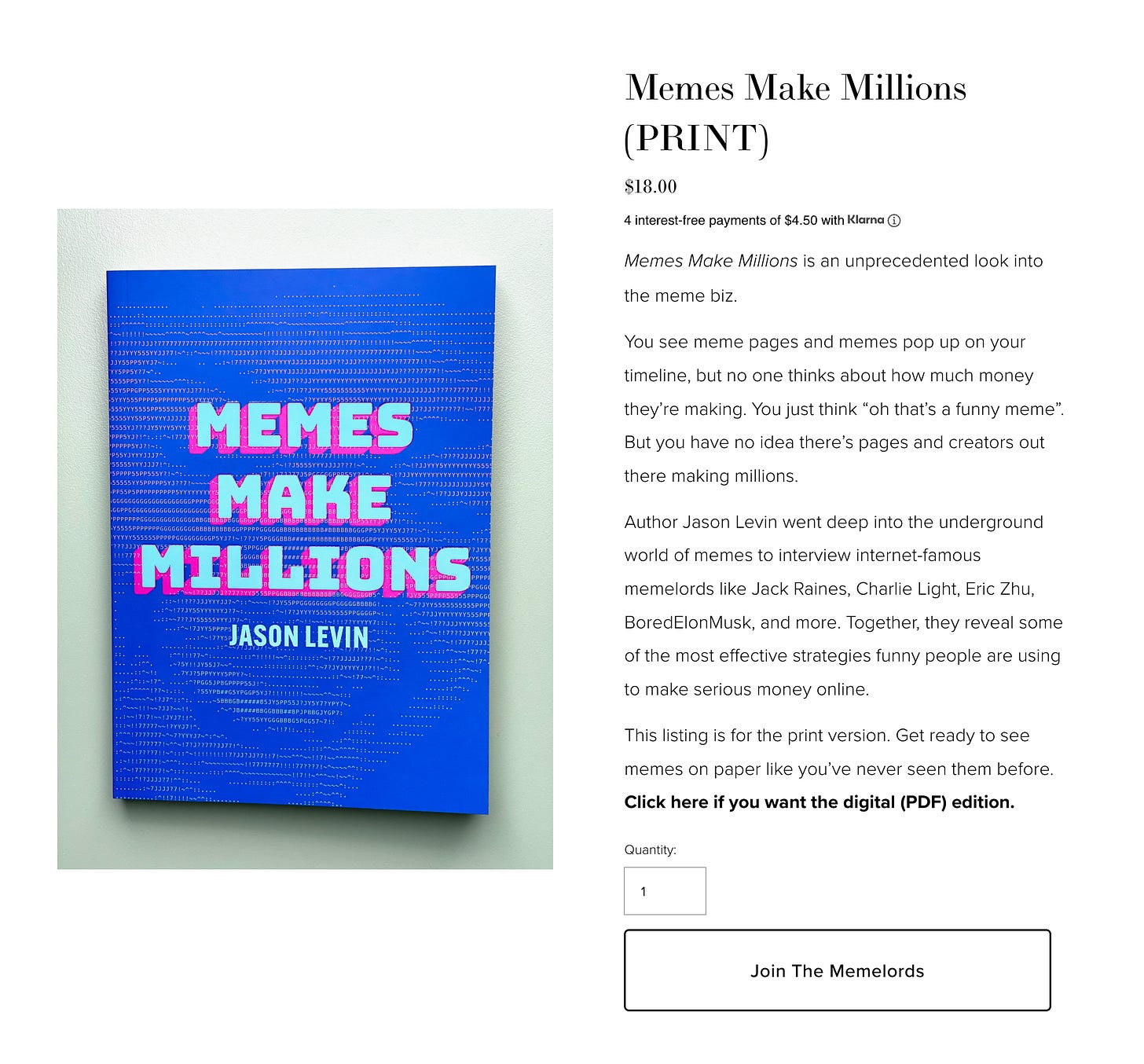
This brings us to meme culture's most significant dimension: its unprecedented political potency.



